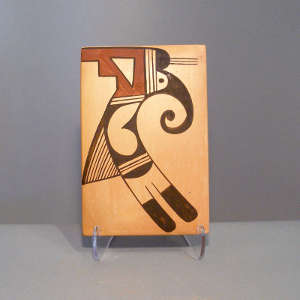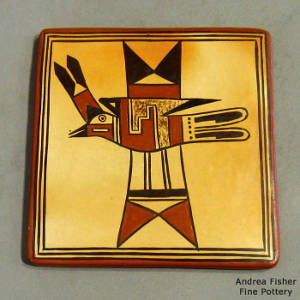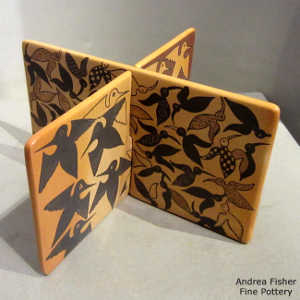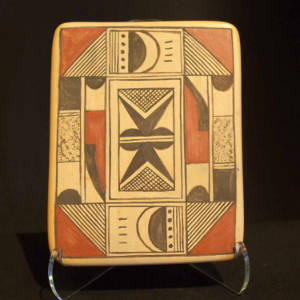Shapes and Forms: Tiles

Polychrome tile with bird elements
and geometric design
Sadie Adams, Hopi
5.75 in H by 4 in W
c. 1935

Polychrome tile with bird elements
and geometric design
Rachel Sahmie, Hopi-Tewa
5.5 in H by 5.25 in W

Polychrome interlocking tiles decorated with a bird design, by Mark Tahbo, Hopi
4.5 in H by 8.25 in W
Most of the tiles I have seen come from Hopi potters but because of the tourist trade, tiles have been made in several other pueblos, too. It's because of the tourist trade that Native American artists began producing tiles as the form is not a traditional form. It is also said that tiles and plates, because of their need to be flat, are among the hardest shapes to make. Harder yet are the round, triangular and hexagonal tiles made by some potters.
Historically, the premier tile-maker was Hopi potter Sadie Adams but many Hopi potters have made tiles over the years. These days Darlene James Nampeyo produces mostly tiles and Rachel Sahmie regularly produced a few.
Some pueblos, because of differences in their local clay, make slab pieces and cook them for use as temper. Once cooked, those pieces are broken up and ground so the powder can be mixed properly with their base clays to produce the desired results. Some pueblo potters also collect ancient pot sherds and grind those up for use as temper.
Most Hopi and some Zuni clays come with a hint of mica in them. Clays from the northern Rio Grande tend to have a larger mica element in them. Mica also serves as a tempering agent. Some potters have used mica to accent parts of their designs, but that mica has to be powdered first, especially on something like a tile.
